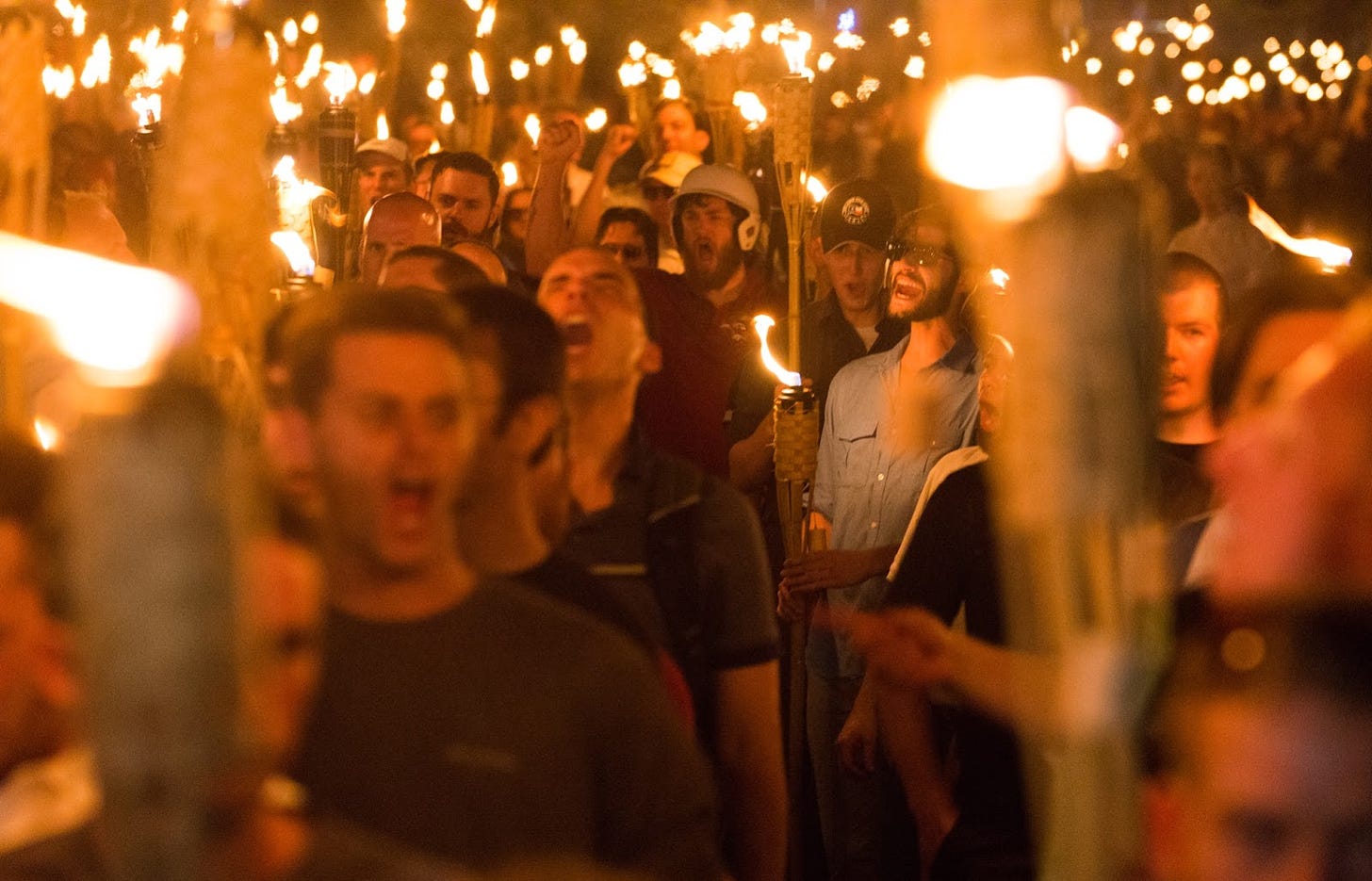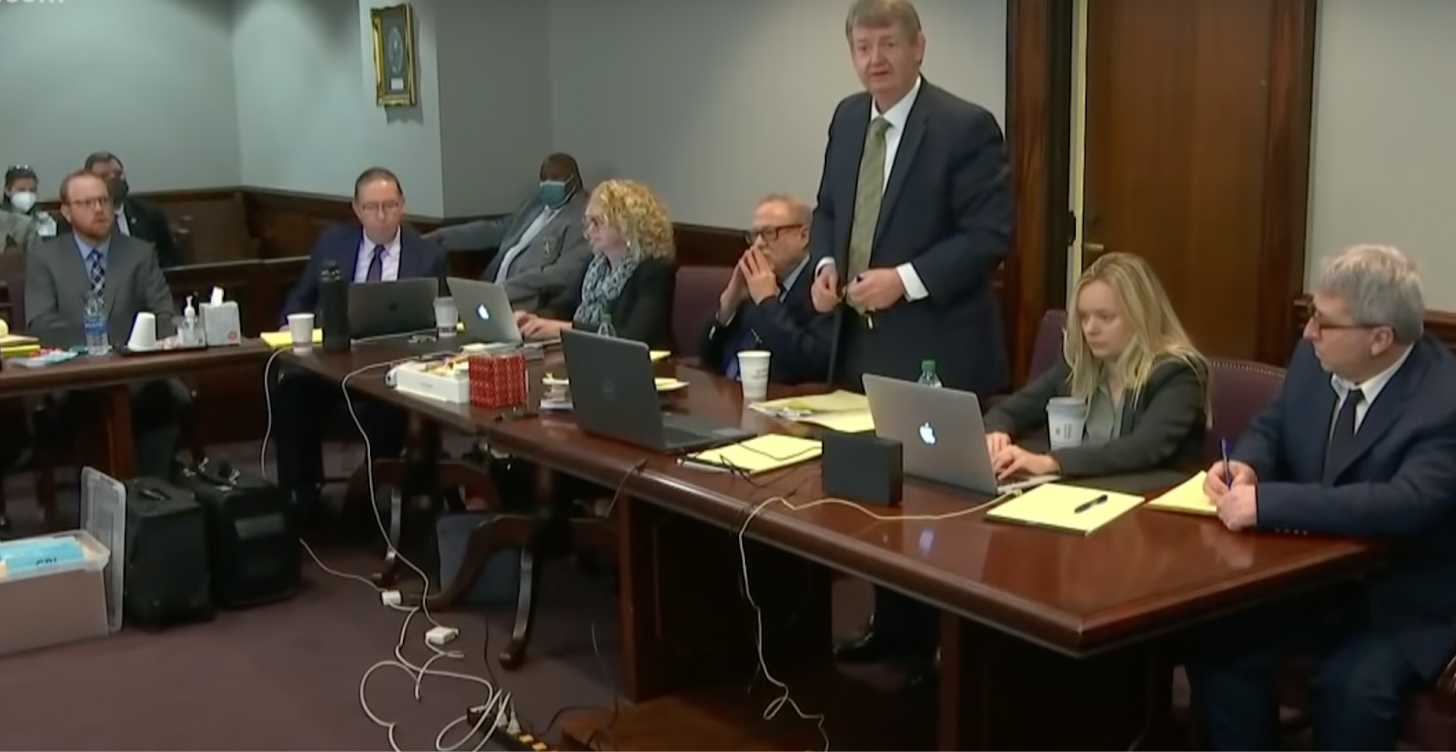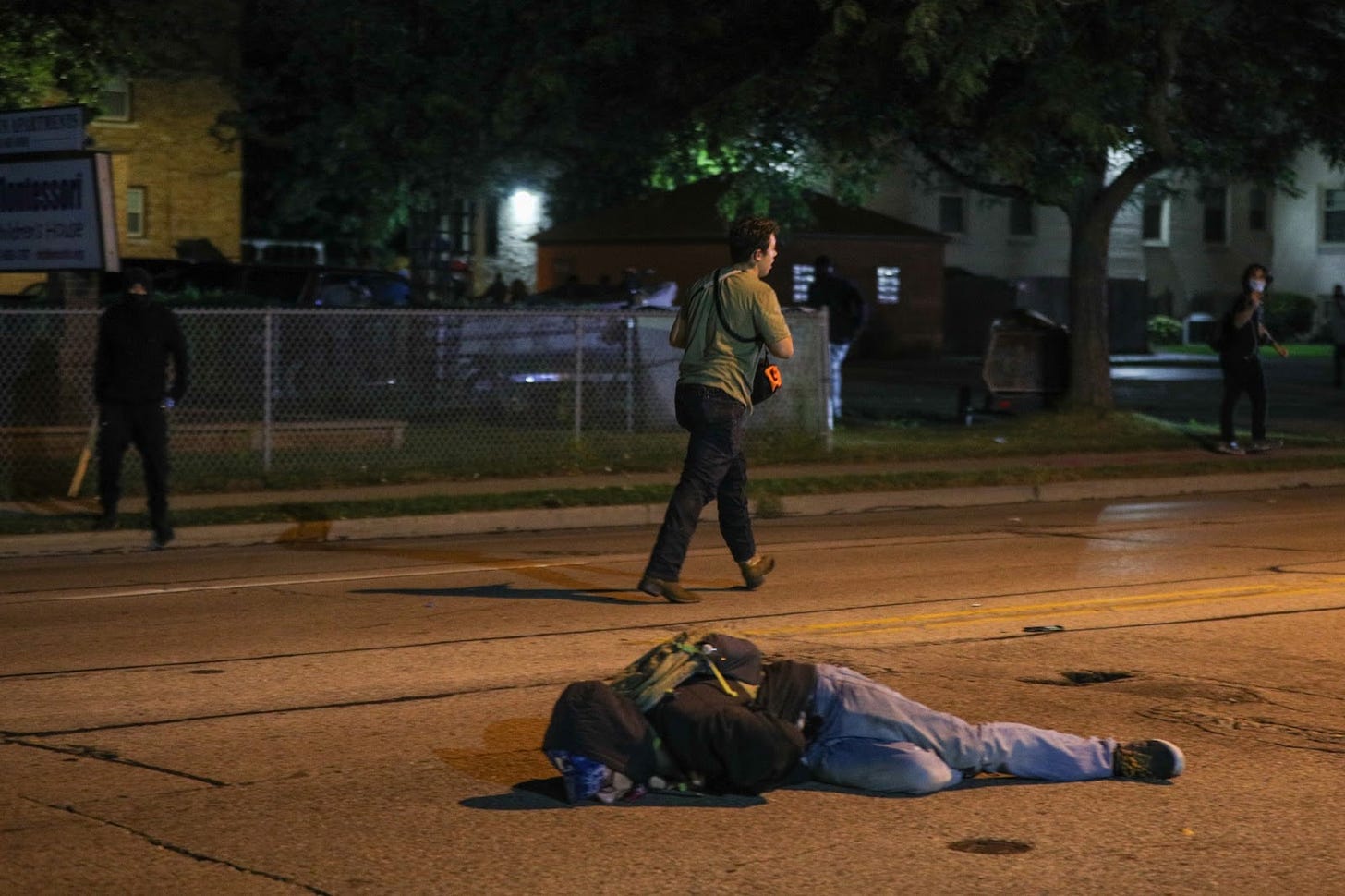White Supremacy on Trial
Checking in on courtrooms in Wisconsin, Virginia, and Georgia
This week, the judges presiding over two high-profile trials were in the news at the same time, and for diametrically opposing reasons. In Kenosha, Wisconsin, Judge Bruce Schroeder, erratically and cruelly presiding over the prosecution of teen killer Kyle Rittenhouse, has disallowed the admission of a video of the defendant saying he wanted to “shoot looters.” Meanwhile, in Brunswick, Georgia, Judge Timothy Walmsley refused point-blank to exclude Black pastors from the courtroom in the trial of the killers of 25-year-old Ahmaud Arbery.
It’s particularly difficult to track trials you care about—trials that bear directly on the issue of white power and white supremacy in this nation—when multiple trials you care about are unfolding at the same time, in a swirl of voir dire and jury instructions and opening and closing arguments. At the current moment, three trials of national significance to the white-power movement and adjacent ideologies are unfolding at the same time. All of these cases merit attention and understanding, more than the average bear can devote on a weekday or series of consecutive weekdays. In lieu of my usual long and winding essay offering historical context, here are some small lumps of thought and links about what’s going on right now with violent white supremacy and the courts.
Sines. V Kessler (Charlottesville, VA)
This is a remarkable case—one of vanishingly few in the last century to be brought under the auspices of the K.K.K. Act of 1871, which makes it illegal to engage in racially motivated violence planned in advance. It is a civil suit brought by numerous plaintiffs who were directly impacted—physically, financially, and emotionally—by the nightmarish two-day melee known as Unite the Right, which brought together many disparate factions of the white nationalist movement in the college town of Charlottesville, Virginia, in August, 2017. (The infamous torch march, which is statutorily required to be the photo accompanying any article about the white power movement, was preceded by numerous other violent sorties into the town throughout the summer of 2017, including a full-bore Ku Klux Klan rally on June 8, 2017). The central argument of the case, brought by the plaintiffs under the aegis of a nonprofit called Integrity First for America, is that the defendants engaged in a conspiracy to commit acts of racially motivated violence in Charlottesville on August 11th and 12th, 2017.

The defendants constitute a grab bag of ghouls who represent a sort of exoskeleton of the white power movement as it looked in the first year of Donald Trump’s presidency; in evidence are months and years of chats and texts revealed in the discovery process. Among the defendants are Jason Kessler, the rally’s chief organizer and an absolute shitstain; Richard Spencer (the “dapper Nazi”); Christopher Cantwell (the “crying Nazi”); various members of the neo-Confederate League of the South, including their chief propagandist Brad Griffin; the leadership of the neo-Nazi groups the Traditionalist Workers Party and the National Socialist Movement; the leadership of Vanguard America, now known as Identity Evropa, a fascist white supremacist group; and arch-propagandists of the white-power movement, Andrew Anglin (who runs the most well-known neo-Nazi tabloid on the Internet, the Daily Stormer, whose very name is a reference to Hitler’s favorite tabloid Der Sturmer) and Augustus Sol Invictus (a wife-beating, goat-blood drinking Satanist Nazi who ran for president in 2020 on the platform that only white men should be allowed to own property). The East Coast Knights of the Ku Klux Klan are also on trial.
Most of these defendants are fairly broke (and certainly not in a position to pay multimillion-dollar damages); Spencer and Cantwell are acting as their own lawyers, which has chiefly meant that witnesses and plaintiffs have been forced to undergo painful and farcical testimony in which they must answer to the very gremlins who engineered their trauma. Still, the hope is to break the back of organized white-supremacy in the U.S. and set a precedent deterring anyone else who plans to terrorize a town while shouting and waving swastikas about. It’s been a fascinating and often hideous proceeding, as the fawning and weird messages Nazis send each other (“we’re raising an army, my liege”) get dragged into the light of day. Holocaust deniers have cross-examined an internationally renowned Holocaust scholar. The defendants are kind of a mess, but that never precluded anyone from being dangerous.
The trial is currently going into its fourth week. For coverage, local antifascist activist Molly Conger is doing a heroic job live-tweeting the blow-by-blow every day and streaming on Twitch every weeknight to summarize that day’s activity. (Disclosure: we’re friends and I help moderate the Twitch chat.) You can also check out the Charlottesville Daily Progress for more locally-based coverage.
The State of Georgia vs. McMichael et Al
This is one of two ongoing trials in which white vigilantism—and the plastic and overgenerous definitions of “self-defense” that percolate throughout right-wing discourse—are at issue before a court of law.

The case concerns the killing of 25-year-old Ahmaud Arbery in Glynn County, Virginia; Arbery was an unarmed Black man out for a jog when he was chased down and killed by three white men: Gregory McMichael, 64, a former Glynn County Police officer (1982-1989) and investigator for the Glynn County District Attorney’s Office (1995-2019); his son Travis McMichael (34), and their neighbor, William “Roddie” Bryan (50). Gregory McMichael postulated that Arbery looked like a criminal, so the three chased him down, and shot him to death. Bryan took a video of the killing that was leaked and went viral online; it looked like an execution of an unarmed man, because it was. Nonetheless, it took 74 days and multiple prosecutorial recusals for any arrest to be made. The first DA to handle the case, Jackie Johnson, was recently indicted for prosecutorial misconduct in the case, which she refused to pursue. The video made such waves—and was greeted with such glee by white-power racists across the nation—that in those putrid circles, “jogger” became a euphemism for the N-word.
The Sword and the Sandwich is a newsletter about serious extremism and equally serious sandwiches. Please consider supporting this work with a paid subscription:
At issue in the case is whether the incident was a botched “citizens’ arrest” (which the defendants maintain was their aim) or a vigilante execution. The trial is in its seventh day, as the state builds its belated case against the men, who face life sentences if convicted. They claim that Arbery was reaching for the gun when he was shot to death, and that therefore their actions constitute self-defense.
One of the defense lawyers, Kevin Gough, has repeatedly objected to the presence of “Black pastors” in the courtroom—Al Sharpton and Jesse Jackson have made appearances (the judge has rejected such objections in no uncertain terms.) All but one Black juror were struck from the final pool in the prelude to the trial. The issue before the court is the killing of one Black man; the larger issues swirling around it include the ways in which law enforcement—of which DAs certainly form a part—protect their own even in the most egregious cases; of how formless and limp laws against violence become when a white man takes a gun into his hands; and the long, long history of anti-Black vigilante action in this country, particularly in the South. At one point in the trial, Arbery’s mother, Wanda Cooper-Jones, burst into tears when a photo of her son as a boy was displayed. This led defense lawyers to call for a mistrial. The judge, Timothy Walmsley, rejected the motion, saying that “emotions are neither unreasonable nor unexpected during murder trials.” Cooper-Jones has endured watching video of her son’s killing in the courtroom—it is difficult to even imagine what an unreasonable emotion in response to this would be. But the demand of the defense is her silence.
State of Wisconsin vs. Kyle Rittenhouse
There’s really too much to say about the Kyle Rittenhouse case—which has just closed and in which jury deliberations are now beginning—to include in this sort of flip summary. If you’ve read this far, you’re likely to know quite a bit about the case, so I won’t go into too much detail, because frankly, it makes me sick.

The bare facts are these: Rittenhouse is eighteen years old. On August 25, 2020, when he was 17, he killed two people, Joseph Rosenbaum, 36, and Anthony Huber, 26, and severely wounded a third man, 27-year-old Gaige Grosskreutz, after driving 45 minutes across state lines to Kenosha, the small Wisconsin city where protests were unfolding over the shooting of Jacob Blake, a 29-year-old father of three who was shot and partially paralyzed by police in front of his children.
It’s worth noting that in conservative media, both online and off, the Black Lives Matter protests of the summer of 2020 were portrayed as catastrophic, barbaric waves of calumny, which caused untold damage to every major metropolitan area of the United States, the financial toll for which rose to the billions. That this was a sinister, shadowy, calculated attack on the American way of life, and so on. These allegations are untrue and they would be laughable if they were not so widely believed, and so frequently invoked as justification for other atrocities, Rittenhouse’s included.
The judge in the case, Bruce Schroeder, has commanded national attention for being, in any reasonable view, syrupy with the defense and brusque with the prosecution. (This is a notable, and highly conditioned, reversal for Schroeder, whose history of cruel rulings against defendants accused of shoplifting and sex workers in his history on the bench since 1983 earned him the nickname “Bruce the Terrible.”)

I briefly interviewed Melissa “Claudio” Lewis, an antifascist journalist who has been providing livetweet coverage of the trial, about her impressions of the trial thus far and Schroeder in particular.
“I’m someone who watches a lot of trials, and Schroeder’s behavior has struck me as particularly egregious. I’m fearing Rittenhouse will get off simply because Schroeder has sowed so much doubt concerning basic modern technology,” Lewis told me. (Schroeder disallowed video evidence at one point because the prosecution had zoomed in, an action Schroeder appeared to profoundly misunderstand as introducing new and potentially false evidence.) “Judges have almost impeachable power… We have a court system that tries that single out behavior that may be unlawful, not someone’s character. But I continue to find it disturbing that Schroeder has disallowed Kyle’s stated desire to ‘shoot looters’ not even two weeks ago. How is this not an indication he had a desire to do what he did?
“I am no fan of district attorneys, and would normally love to see them get grilled. But the preferential treatment is pretty stark. Kyle was barely forced to answer yes or no while questioned during [Kenosha County DA] Binger’s cross-examination. Schroeder seems like a judge who holds grudges, and since his original altercation has not only held Binger on a leash: it’s a choke chain.”
In addition to Lewis’s tweets, you can also check out the running New York Times liveblog, with the strong caveat that it’s the New York Times.
The jury, whose deliberations begin today, will once again be pondering the question of what constitutes self-defense; whether there is any circumstance in which that defense is inapplicable when the purported self-defender is a white man with a gun. Absent a very surprising ruling, it seems likely that Rittenhouse will walk, delighting his legions of right-wing fans. He’s already raised $500,000 for legal expenses on Christian crowdfunding site and far-right haven GiveSendGo, including contributions from current and former law enforcement officers and public officials. Right now, you can buy a T-shirt whose back displays a picture of Rittenhouse proudly bearing his AR-15, with the words “The tree of liberty must be refreshed from time to time with the blood of commies.” (It’s a slight tweak on a real quote from Thomas Jefferson—replace “tyrants” for “commies”—that is beloved among militias, right-wing vigilante movements, and white power activists trying to appeal to the former.) The front says “Kyle Rittenhouse Did Nothing Wrong!” It remains to be seen whether the jury will agree.






Thanks for the recap. I grew up in Waukegan, 2 towns south of Kenosha. I also grew up around the elder generations of both Rittenhouse and Huber in the parks and Ravine's of Zion, IL. I never met Kyle but from encounters with his family, I don't doubt that he was raised precisely for the task he performed. So was I and it took years of therapy and deprogramming to be the functional mess I am today. I'm absolutely terrified of what legal vindication and the adoration of the culture warlords will do for others like him.
I find it depressing that in 2021 we have adjectives for Nazis that aren't "deceased for seventy years."